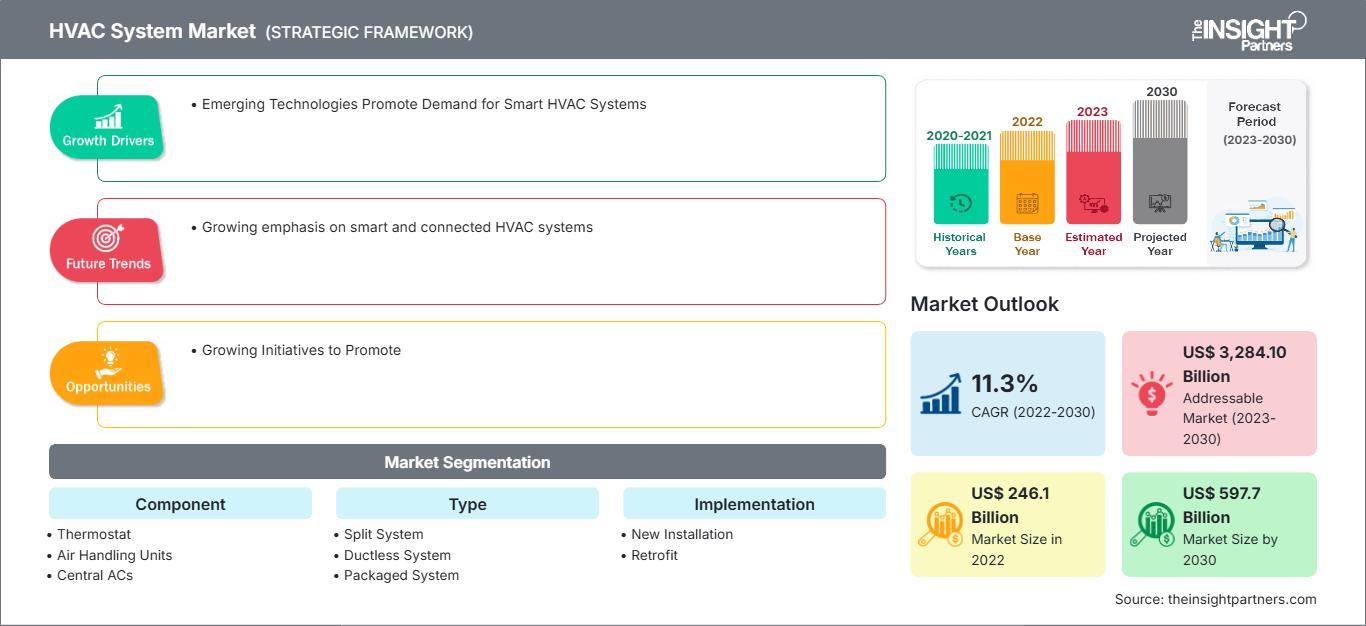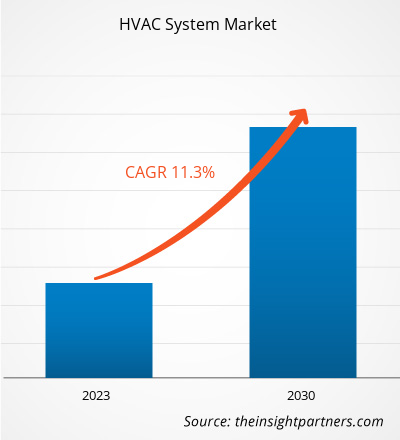Der Markt für HLK-Systeme wird im Jahr 2024 voraussichtlich ein Volumen von 158,33 Milliarden US-Dollar erreichen und bis 2031 auf 243,86 Milliarden US-Dollar anwachsen. Für den Zeitraum 2025–2031 wird ein durchschnittliches jährliches Wachstum (CAGR) von 6,46 % erwartet.
Marktanalyse für HLK-Systeme
Weltweit steigt der Strombedarf aufgrund des Ausbaus von Rechenzentren, der rasanten Elektrifizierung des Verkehrssektors und des zunehmenden Komfortbedarfs in Gewerbe- und Wohngebäuden. Der sich verschlechternde Zustand von Gebäuden und die Verschärfung der Vorschriften zu Energieeffizienz und Emissionen sind die Hauptfaktoren für die weltweit steigende Nachfrage nach HLK-Systemen. Um Käufer zu gewinnen, statten Hersteller ihre energieeffizienten Kältemaschinen, Wärmepumpen und VRF-Systeme mit Kältemitteln mit niedrigerem GWP-Wert, intelligenten Steuerungen und modularen Bauweisen aus.
Marktübersicht für HLK-Systeme
Heizungs-, Lüftungs-, Klima- und Kälteanlagen (HLK-Anlagen) sind weltweit die Hauptquelle für Komfort und Luftqualität in Wohn-, Gewerbe- und Industriegebäuden. Derzeit wird die Nachfrage nach innovativen HLK-Systemen vor allem durch die Anforderungen an hohe Energieeffizienz, präzise Klimaregelung und verbesserte Raumluftqualität getrieben – ein Muss für Neubauten in unterschiedlichen Klimazonen.
Passen Sie diesen Bericht Ihren Anforderungen an.
Sie erhalten eine kostenlose Anpassung aller Berichte – einschließlich Teilen dieses Berichts, Länderanalysen und Excel-Datenpaketen – sowie attraktive Angebote und Rabatte für Start-ups und Universitäten.
Markt für HLK-Systeme: Strategische Einblicke

-
Ermitteln Sie die wichtigsten Markttrends dieses Berichts.Diese KOSTENLOSE Probe beinhaltet eine Datenanalyse, die von Markttrends bis hin zu Schätzungen und Prognosen reicht.
Markttreiber und Chancen für HLK-Systeme
Markttreiber:
- Steigender globaler Strombedarf: Der steigende Pro-Kopf-Stromverbrauch in den führenden Volkswirtschaften wird durch Rechenzentren, das Laden von Elektrofahrzeugen und die rasche Urbanisierung verursacht und treibt das Marktwachstum an.
- Modernisierung alternder HLK-Systeme: In Nordamerika, Europa und Asien werden Nachrüstungs- und Leistungsvertragsprojekte, die auf die Senkung der Betriebskosten und die Erhöhung der Ausfallsicherheit abzielen, zur wichtigsten Austauschstrategie.
- Verschärfung der Umwelt- und Effizienzvorschriften: Verschärfte Umwelt- und Effizienzvorschriften treiben den globalen Übergang zu kohlenstoffarmen, leistungsstarken Systemen voran.
Marktchancen:
- Intelligente, vernetzte HLK-Systeme mit KI-Optimierung: Der Markt ist bereit für Gebäudeleittechnik, integrierte, cloudbasierte und vernetzte HLK-Systeme, die KI für vorausschauende Planung, Fehlererkennung und Echtzeitoptimierung einsetzen.
- Elektrifizierung, Wärmepumpen und das Ökosystem der Elektrofahrzeuge: Die Elektrifizierung von Gebäuden und das Wachstum von Ladeinfrastrukturnetzen für Elektrofahrzeuge verändern den Markt für Heizungs-, Lüftungs- und Klimaanlagen.
- Elektrifizierung von Wohnhäusern und Smart Homes: Haushalte steigen von fossil befeuerten Heizkesseln auf elektrische Wärmepumpen um. Diese Wärmepumpen sind in der Regel mit intelligenten Thermostaten, Sensoren und Energiemanagement-Plattformen für das Haus vernetzt.
Marktbericht für HLK-Systeme: Segmentierungsanalyse
Der Markt für HLK-Systeme (Heizung, Lüftung, Klimaanlage) ist in verschiedene Segmente unterteilt, um einen besseren Überblick über seine Funktionsweise, sein Wachstumspotenzial und die neuesten Trends zu ermöglichen. Nachfolgend ist der in Branchenberichten übliche Segmentierungsansatz dargestellt:
Nach Typ:
- Split-System: Split-Systeme ermöglichen energieeffizientes Kühlen/Heizen durch Innen-/Außengeräte ohne Verwendung von Kanälen und sind daher ideal für die Zonensteuerung in Häusern mit steigenden SEER-Standards.
- Kanalloses System: Kanallose Mini-Split-Klimaanlagen sind mit einem Marktanteil von 40 % führend und eine ideale Lösung für die Nachrüstung in alten Häusern, in denen keine Kanäle vorhanden sind. Dadurch wird eine flexible Zoneneinteilung und Energieeinsparungen von bis zu 30 % gemäß DOE-Daten ermöglicht.
- Kompaktsystem: Kompaktsysteme verfügen über alle Komponenten, die in einem einzigen Schrank für Dachinstallationen integriert sind; daher eignen sie sich ideal für Gewerbeflächen mit begrenztem Platzangebot, wobei der Hauptgrund für ihren Einsatz die schnelle Installation in Neubauten ist.
Durch die Umsetzung:
- Neuinstallation:
- Nachrüstung:
Auf Antrag:
- Wohnen
- Kommerziell
- Industrie
Nach Komponente:
- Thermostat
- Lüftungsanlagen
- Zentrale Klimaanlage
- Ofen
- Wärmepumpe
- Kompressor
- Andere
Nach Geographie:
- Nordamerika
- Europa
- Asien-Pazifik
- Südamerika
- Naher Osten und Afrika
Regionale Einblicke in den Markt für HLK-Systeme
Die regionalen Trends und Einflussfaktoren auf den Markt für HLK-Systeme im gesamten Prognosezeitraum wurden von den Analysten von The Insight Partners ausführlich erläutert. Dieser Abschnitt behandelt außerdem die Marktsegmente und die geografische Verteilung des HLK-Systemmarktes in Nordamerika, Europa, Asien-Pazifik, dem Nahen Osten und Afrika sowie Süd- und Mittelamerika.
Berichtsumfang zum Markt für HLK-Systeme
| Berichtattribute | Details |
|---|---|
| Marktgröße im Jahr 2024 | 158,33 Milliarden US-Dollar |
| Marktgröße bis 2031 | 243,86 Milliarden US-Dollar |
| Globale durchschnittliche jährliche Wachstumsrate (2025 - 2031) | 6,46 % |
| Historische Daten | 2021-2023 |
| Prognosezeitraum | 2025–2031 |
| Abgedeckte Segmente |
Nach Typ
|
| Abgedeckte Regionen und Länder |
Nordamerika
|
| Marktführer und wichtige Unternehmensprofile |
|
Marktdichte der Akteure im Bereich HLK-Systeme: Auswirkungen auf die Geschäftsdynamik verstehen
Der Markt für HLK-Systeme wächst rasant, angetrieben durch die steigende Nachfrage der Endverbraucher. Gründe hierfür sind unter anderem sich wandelnde Verbraucherpräferenzen, technologische Fortschritte und ein wachsendes Bewusstsein für die Vorteile der Produkte. Mit steigender Nachfrage erweitern Unternehmen ihr Angebot, entwickeln innovative Lösungen, um den Kundenbedürfnissen gerecht zu werden, und nutzen neue Trends, was das Marktwachstum zusätzlich beflügelt.

- Verschaffen Sie sich einen Überblick über die wichtigsten Akteure im Markt für HLK-Systeme.
Marktanteilsanalyse für HLK-Systeme nach Regionen
Der Markt für HLK-Systeme im asiatisch-pazifischen Raum wächst aufgrund von Faktoren wie Urbanisierung, einer großen Anzahl von Gewerbebauprojekten, steigendem Komfortniveau der Mittelschicht und heißem und feuchtem Klima rasant.
Nachfolgend eine Zusammenfassung der Marktanteile und Trends nach Regionen:
1. Nordamerika
- Marktanteil: Ein ausgereifter Markt für Heizungs-, Lüftungs- und Klimatechnik mit hoher Durchdringung in Wohn- und Gewerbegebäuden, angetrieben durch die Nachfrage nach Ersatzsystemen, die Einhaltung von Energievorschriften und die Modernisierung veralteter Anlagen.
-
Wichtigste Einflussfaktoren:
- Hausbesitzer rüsten ihre alten Heizungs-, Lüftungs- und Klimaanlagen auf hocheffiziente Wärmepumpen, VRF-Systeme und moderne Steuerungssysteme um, um ihre Energiekosten und Betriebskosten zu senken.
- Trends: Die rasante Verbreitung intelligenter, vernetzter HLK-Systeme ist einer der neuesten Trends in Nordamerika.
2. Europa
- Marktanteil: Ein großer Marktanteil, der durch strenge Klimaziele, rigorose Bauvorschriften und die weitverbreitete Nutzung von Fernwärme- und Fernkältenetzen gestützt wird.
-
Wichtigste Einflussfaktoren:
- Der großflächige Einsatz von Wärmepumpen zur Raum- und Wassererwärmung ist der Haupttreiber der Dekarbonisierung in der EU.
- Trends: Zu den neuesten Trends, die von Experten auf diesem Gebiet diskutiert werden, gehören der Einsatz von Kältemitteln mit niedrigem GWP, die vorrangige Verwendung von Hybrid-Wärmepumpen-/Kesselsystemen sowie die Integration von HLK-Anlagen mit erneuerbaren Energien vor Ort und Wärmespeichern für nahezu Nullenergiegebäude.
3. MEA
- Marktanteil: Ein schnell expandierender, klimabedingter Kühlmarkt mit hoher Nachfrage in den Golfstaaten und den wachsenden urbanen Zentren.
-
Wichtigste Einflussfaktoren:
- Einer der Hauptfaktoren, der dazu geführt hat, dass große zentrale Kühlsysteme notwendig geworden sind, sind die extremen Temperaturen, die die Region kennzeichnen, neben der Entwicklung des Tourismus- und des Handelssektors.
- Trends: Einsatz hocheffizienter Kältemaschinen, Meerwasser- und Wärmespeicherkühlung sowie zunehmendes Interesse an solarbetriebenen und hybriden HLK-Lösungen für nachhaltige Megaprojekte.
4. Asien-Pazifik
- Marktanteil: Die Region mit dem größten und am schnellsten wachsenden Markt für Heizungs-, Lüftungs- und Klimatechnik (HLK), vor allem China, Indien, Japan und Südostasien, ist führend.
-
Wichtigste Einflussfaktoren:
- Urbanisierung, Bauboom und steigende Komfortansprüche der Mittelschicht.
- Trends: Eine starke Nachfrage nach inverterbasierten Raumklimageräten, VRF in Gewerbegebäuden, Lokalisierung der Wärmepumpenherstellung und die Integration von HLK-Systemen in Smart-City- und Gebäudemanagementplattformen.
5. Südamerika
- Marktanteil: Der Markt ist beachtlich, aber stetig wachsend und konzentriert sich hauptsächlich auf Brasilien, Mexiko, Chile und Kolumbien.
-
Wichtigste Einflussfaktoren:
- Die Expansion der Sektoren Gewerbeimmobilien, Einzelhandel und Gastgewerbe, die die Hauptabnehmer moderner HLK-Systeme sind.
- Trends: Der lokale Markt bewegt sich allmählich von der Verwendung einfacher Split-Geräte hin zu effizienteren Inverter-Systemen, natürliche Kältemittel mit niedrigem GWP werden vermehrt eingesetzt, und es gibt mehr von ESCOs getriebene Nachrüstungsprojekte, die darauf abzielen, die mit der Kühlung verbundenen Stromkosten zu senken.
Marktdichte der Akteure im Bereich HLK-Systeme: Auswirkungen auf die Geschäftsdynamik verstehen
Hohe Marktdichte und starker Wettbewerb
Der Wettbewerb ist aufgrund der Präsenz etablierter Akteure wie Carrier Global Corporation, Trane Technologies plc und Daikin Industries, Ltd. stark. Regionale und Nischenanbieter wie Systemair AB und Trane Technologies Plc tragen ebenfalls zur Wettbewerbslandschaft in den verschiedenen Regionen bei.
Dieser hohe Wettbewerbsdruck zwingt Unternehmen dazu, sich durch folgende Angebote von der Konkurrenz abzuheben:
- Hocheffiziente Wärmepumpen und VRF-Systeme mit SEER-Werten von 25+.
- Maßgeschneiderte IoT-fähige Lösungen für Rechenzentren, erneuerbare Energien und intelligente Gebäude.
- Kostengünstige Fertigung mit Kältemitteln mit niedrigem GWP-Wert.
- Robuster Kundendienst durch prädiktive Analysen und Ferndiagnose.
Chancen und strategische Schritte
- Energieversorger und Gebäudeeigentümer haben sich mit IoT-Anbietern zusammengetan, um den Überblick zu behalten und gleichzeitig die Effizienz und Wartung bei gewerblichen Modernisierungen und Rechenzentren zu verbessern.
- Die Hersteller treiben die Entwicklung intelligenter HLK-Systeme weiter voran, indem sie KI-Steuerungen, Technologien mit niedrigem GWP-Wert und Cloud-Plattformen zur Echtzeitoptimierung integrieren.
- Kleine, modulare VRF-/kanallose Konzepte werden immer beliebter; dadurch ermöglichen sie den einfachen Übergang von alten zu neuen Gebäuden, ohne dass eine komplette Überholung erforderlich ist.
Die wichtigsten Unternehmen, die auf dem nordamerikanischen Markt für HLK-Systeme tätig sind, sind:
- Daikin Industries Ltd
- Johnson Controls International Plc
- Carrier Global Corp
- Honeywell International Inc
- Mitsubishi Electric Corp
- Robert Bosch GmbH
- Systemair AB
- LG Electronics Inc
- Emerson Electric Co
- Hitachi Ltd
- Trane Technologies Plc
Hinweis: Die oben aufgeführten Unternehmen sind nicht in einer bestimmten Reihenfolge geordnet.
Weitere im Rahmen der Studie analysierte Unternehmen:
- Ingersoll Rand Plc
- Nortek Air Solutions
- GE Appliances, ein Unternehmen von Haier
- Electrolux AB
- Syntec Luftstromsysteme
- Andere
Neuigkeiten und aktuelle Entwicklungen auf dem Markt für HLK-Systeme
- Carrier Global Corporation kündigt Investitionspläne in Höhe von 1 Milliarde US-Dollar in den USA an. Im Mai 2025 kündigte die Carrier Global Corporation, ein weltweit führender Anbieter intelligenter Klima- und Energielösungen, Pläne an, über fünf Jahre zusätzlich 1 Milliarde US-Dollar in die US-amerikanische Fertigung, Innovation und den Ausbau der Belegschaft zu investieren – zusätzlich zu ihren laufenden Verpflichtungen gegenüber dem amerikanischen Betrieb.
- Daikin Applied hat den Grundstein für den Bau einer neuen, energieeffizienten Produktionsstätte in Mexiko gelegt. Im Juni 2024 erfolgte der Spatenstich für den Bau einer neuen, energieeffizienten Produktionsstätte durch Alliance Air, eine Tochtergesellschaft von Daikin Applied, einem weltweit führenden Hersteller von Klimatechnik für Gewerbe und Industrie. Ziel der neuen Produktionsstätte ist es, das nachhaltige Wachstum von Rechenzentren in Nordamerika zu unterstützen.
Marktbericht zu HLK-Systemen: Abdeckung und Ergebnisse
Der Bericht „Marktgröße und Prognose für HLK-Systeme (2021–2031)“ bietet eine detaillierte Analyse des Marktes, die folgende Bereiche abdeckt:
- Marktgröße und Prognose für HLK-Systeme auf globaler, regionaler und Länderebene für alle abgedeckten Segmente
- Trends im Markt für HLK-Systeme sowie Dynamiken wie Treiber, Hemmnisse und wichtige Chancen
- Detaillierte PEST- und SWOT-Analyse
- Marktanalyse für HLK-Systeme mit Fokus auf wichtige Trends, globale und regionale Rahmenbedingungen, Hauptakteure, regulatorische Rahmenbedingungen und aktuelle Entwicklungen
- Branchenlandschafts- und Wettbewerbsanalyse mit Fokus auf Marktkonzentration, Heatmap-Analyse, prominente Akteure und aktuelle Entwicklungen im Markt für HLK-Systeme
- Detaillierte Unternehmensprofile
- Historische Analyse (2 Jahre), Basisjahr, Prognose (7 Jahre) mit CAGR
- PEST- und SWOT-Analyse
- Marktgröße Wert/Volumen – Global, Regional, Land
- Branchen- und Wettbewerbslandschaft
- Excel-Datensatz
Aktuelle Berichte
Erfahrungsberichte
Grund zum Kauf
- Fundierte Entscheidungsfindung
- Marktdynamik verstehen
- Wettbewerbsanalyse
- Kundeneinblicke
- Marktprognosen
- Risikominimierung
- Strategische Planung
- Investitionsbegründung
- Identifizierung neuer Märkte
- Verbesserung von Marketingstrategien
- Steigerung der Betriebseffizienz
- Anpassung an regulatorische Trends






















 Kostenlose Probe anfordern für - Markt für HLK-Systeme
Kostenlose Probe anfordern für - Markt für HLK-Systeme